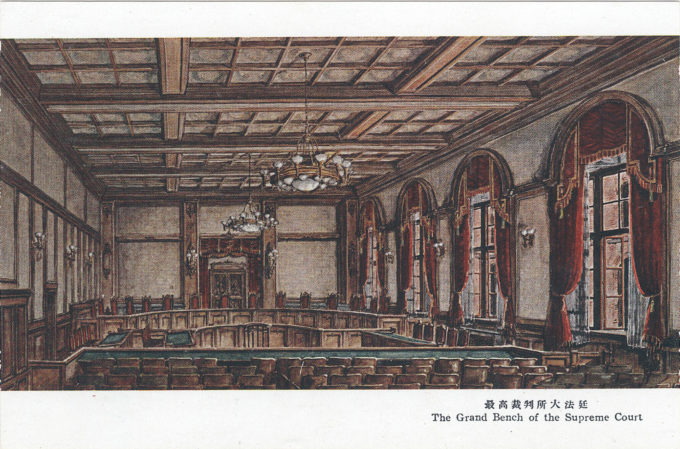
“The Grand Chamber of Justice”, Supreme Court, Tokyo, c. 1930. In session, the Grand Chamber was composed of 1 Supreme Court Chief Justice and 14 Supreme Court Justices to render decisions.
See also:
Taishin-in (Supreme Court, or Court of Cassation), c. 1910.
Justice Ministry, Kasumigaseki, Tokyo, c. 1910.
“There is an old Chinese adage that ‘people shall be made to conform themselves to law. Laws shall not be made known to them.’ In adopting Chinese civilization with its merits and drawbacks [Japan] also imported this principle of Oriental despotism.
“During the regime of the Tokugawa Shogunate the body of laws was, as far as the people were concerned, a sealed book not only in the territories directly governed by the authority of the Shogun but in the respective dominions of the feudal Daimyos who were in a sense independent sovereigns
“… During the Shogunate, the so-called ‘Hundred Articles’ were carefully copied by the officials who were in the privileged position of administering these laws. It is true that whenever an act which had not been a crime heretofore was to be condemned as a crime, special enactment was made public, but the body of the criminal law itself remained unpublished.
“When the Emperor Meiji ascended the throne in 1868 His Majesty took an oath consisting of five declarations, of which the last two read as follows:
“Abusive practices of old shall be abolished, and hereafter the government shall be conducted on the principles of righteousness coextensive with the heavens and the earth;
“Wisdom shall be sought in all parts of the world and the foundation of the Empire thereby strengthened.”
“… In 1880 a penal code based on the principles of French penal code and drafted by a French jurist, Boissonade, was promulgated after a careful revision by the Senate which was a deliberative assembly created by the Emperor Meiji in 1875. That Penal Code took effect in 1882 and marked the beginning of Japan’s adoption of laws based on the principles of European jurisprudence.
“Simultaneously with the creation of a deliberative assembly called the Genroin or Senate, the Court of Cassation [also known as the Supreme Court] was created in 1875 for the unification of judicial interpretation.”
– “Japanese Law Courts: Their Organisation and Jurisdiction”, by the Hon. T. Miyaoka, The Japan Magazine, November 1914

